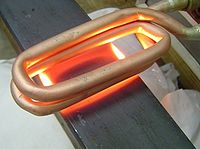Induction Heaters
Induction Heaters are used in several thermal processes such as heating of metals, forging, annealing, heat penetration, melting, and welding.
Induction Heating operating principle
Induction heating results from the direct application of two physical laws, the LENZ law and the JOULE effect: any electrically conductive material placed in a variable magnetic field (generated by an exciting winding called inductor) is the site of induced electric currents, called eddy currents. Due to the Joule effect (P =R x I² ), these currents dissipate heat in the material in which they appeared.
In order to transfer a maximum amount of energy to the part to be treated, The heat generated in the material implies a quick response and a high efficiency.
Several parameters must be taken into consideration:
The respective positions of the inductors and the parts to be treated (coupling, respective lengths).
The supply frequency and the skin effect which characterize the dispersion of the induced current throughout the part: the higher the frequency, the closer to the surface the induced currents will concentrate. This fundamental notion is determined by the penetration depth, also referred to as skin thickness. - simpfied formulae do = 503.3 (ρ/μr f)1/2
The magnetic (relative permeability μr ), electrical (resistivity ρ) and thermal (conductivity) properties of the parts to be heated, most of which vary in accordance with the temperature.
The type of inductor (geometry, type of conductor, technology).
Features
- Heating speed linked to the possibility of obtaining very high power density,
- Exact location of the heating effect thanks to the inductor design and an operating frequency perfectly adapted to the part to be heated,
- The possibility to heat at very high temperatures with an efficiency practically independent of the temperature,
- A process perfectly adapted to industrial medium-sized and mass production requirements
- Easy automation of equipment,
- Absence of thermal inertia (rapid start-up),
- Repeatability of operations carried out,
- Often extremely high heating efficiency,
- Absence of pollution from the source of heating (cold source),
- Good working conditions
Video
